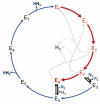On the Shoulders of Giants-Reaching for Nitrogenase
- PMID: 38138449
- PMCID: PMC10745432
- DOI: 10.3390/molecules28247959
On the Shoulders of Giants-Reaching for Nitrogenase
Abstract
Only a single enzyme system-nitrogenase-carries out the conversion of atmospheric N2 into bioavailable ammonium, an essential prerequisite for all organismic life. The reduction of this inert substrate at ambient conditions poses unique catalytic challenges that strain our mechanistic understanding even after decades of intense research. Structural biology has added its part to this greater tapestry, and in this review, I provide a personal (and highly biased) summary of the parts of the story to which I had the privilege to contribute. It focuses on the crystallographic analysis of the three isoforms of nitrogenases at high resolution and the binding of ligands and inhibitors to the active-site cofactors of the enzyme. In conjunction with the wealth of available biochemical, biophysical, and spectroscopic data on the protein, this has led us to a mechanistic hypothesis based on an elementary mechanism of repetitive hydride formation and insertion.
Keywords: energy conversion; enzyme mechanism; molybdenum; nitrogen fixation; nitrogenase; vanadium.
Conflict of interest statement
The author declares no conflict of interest.
Figures







Similar articles
-
Cleaving the n,n triple bond: the transformation of dinitrogen to ammonia by nitrogenases.Met Ions Life Sci. 2014;14:147-76. doi: 10.1007/978-94-017-9269-1_7. Met Ions Life Sci. 2014. PMID: 25416394 Review.
-
Catalysis and structure of nitrogenases.Curr Opin Struct Biol. 2023 Dec;83:102719. doi: 10.1016/j.sbi.2023.102719. Epub 2023 Oct 4. Curr Opin Struct Biol. 2023. PMID: 37802004 Review.
-
Catalytic conversion of nitrogen to ammonia by an iron model complex.Nature. 2013 Sep 5;501(7465):84-7. doi: 10.1038/nature12435. Nature. 2013. PMID: 24005414 Free PMC article.
-
Reactivity, Mechanism, and Assembly of the Alternative Nitrogenases.Chem Rev. 2020 Jun 24;120(12):5107-5157. doi: 10.1021/acs.chemrev.9b00704. Epub 2020 Mar 4. Chem Rev. 2020. PMID: 32129988 Free PMC article. Review.
-
Biological nitrogen fixation in theory, practice, and reality: a perspective on the molybdenum nitrogenase system.FEBS Lett. 2023 Jan;597(1):45-58. doi: 10.1002/1873-3468.14534. Epub 2022 Nov 28. FEBS Lett. 2023. PMID: 36344435 Free PMC article. Review.
Cited by
-
Nitrogen stable isotope fractionation by biological nitrogen fixation reveals cellular nitrogenase is diffusion limited.PNAS Nexus. 2025 Feb 25;4(3):pgaf061. doi: 10.1093/pnasnexus/pgaf061. eCollection 2025 Mar. PNAS Nexus. 2025. PMID: 40099223 Free PMC article.
-
Extending protein-film electrochemistry across enzymology and biological inorganic chemistry to investigate, track and control the reactions of non-redox enzymes and spectroscopically silent metals.J Biol Inorg Chem. 2025 Apr;30(3):209-219. doi: 10.1007/s00775-025-02105-0. Epub 2025 Mar 1. J Biol Inorg Chem. 2025. PMID: 40025220 Free PMC article. Review.
References
-
- Hellriegel H., Willfarth H. Untersuchungen über die Stickstoffnährung der Gramineen und Leguminosen. Beilageheft Z. Ver. Rübenzucker-Ind. Dtsch. Reichs. 1888;38:1–234.
-
- Lipman J.G. Experiments on the transformation and fixation of nitrogen by bacteria. Rep. N. J. Agric. Exper. Stat. 1903;24:217–285.
-
- Smil V. Enriching the Earth: Fritz Haber, Carl Bosch, and the Transformation of World Food Production. MIT Press; Cambridge, MA, USA: 2004.
-
- Bagchi S.N., Ernst A., Böger P. The Effect of Activated Oxygen Species on Nitrogenase of Anabaena variabilis. Z. Naturforsch. C. 1991;46:407–415. doi: 10.1515/znc-1991-5-612. - DOI
Publication types
MeSH terms
Substances
Grants and funding
LinkOut - more resources
Full Text Sources

